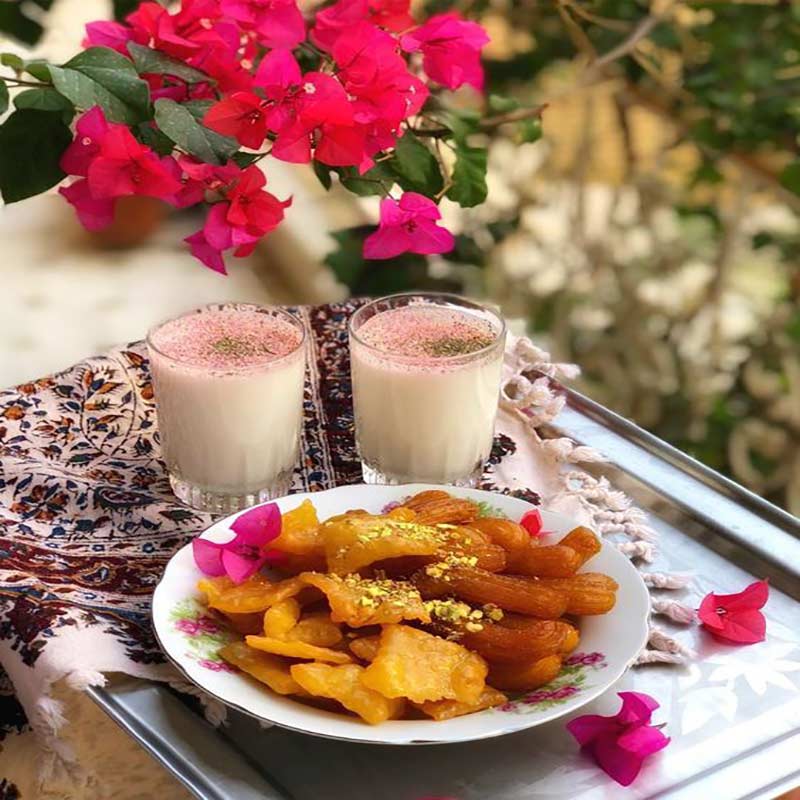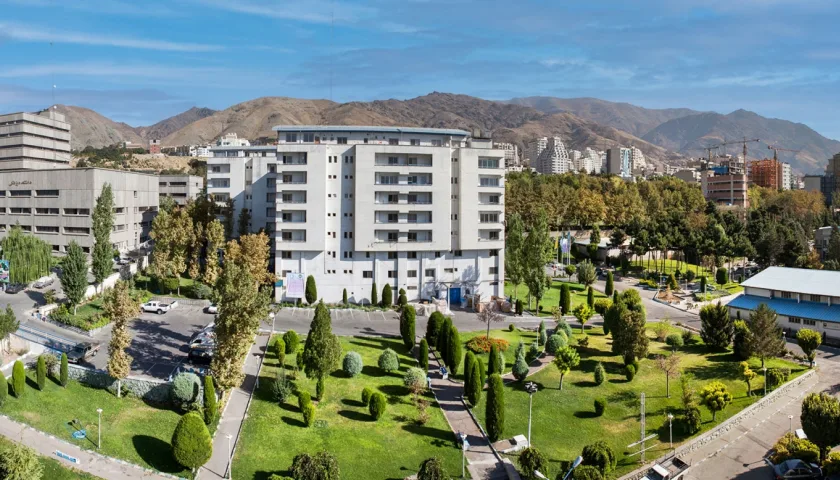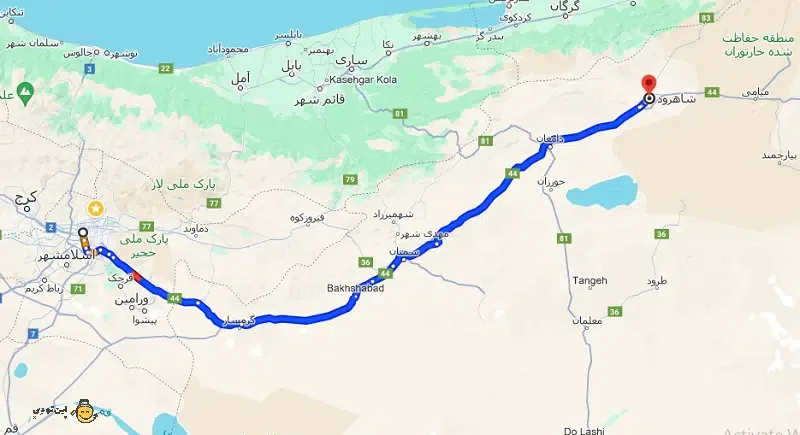Here are 12 of the most fascinating Iranian handicrafts | Handicrafts of iran
Iran, with its vast land and rich history, boasts a diverse array of handicrafts that have gained international renown. Each city, village, and corner of this country has its own roots deeply embedded in the past, reflected in its culture, arts, and traditions. The diversity of handicrafts in Iran serves as a window into the cultural tapestry of its people, showcasing their creativity and artistic prowess.
It’s impossible to encapsulate all the beauty of Iranian handicrafts and the labor of love behind them in a single article, but Gulf City Pedia aims to introduce you to 12 of the most captivating ones.
Minakari (Enameling): This intricate art involves decorating metal surfaces, usually copper or silver, with colorful enamel designs. It’s a traditional Persian art form that dates back centuries, known for its vibrant colors and detailed motifs.
Negargari (Miniature Painting): A delicate form of art, miniature painting involves creating intricate, detailed artworks on a small scale. Persian miniature paintings often depict scenes from literature, mythology, or daily life, characterized by their fine brushwork and rich colors.
Sofreh Embroidery: Sofreh is a traditional Iranian embroidered cloth used as a decorative spread or dining cloth during special occasions. The embroidery on Sofrehs often features elaborate floral patterns and intricate designs, showcasing the skill and creativity of Iranian artisans.
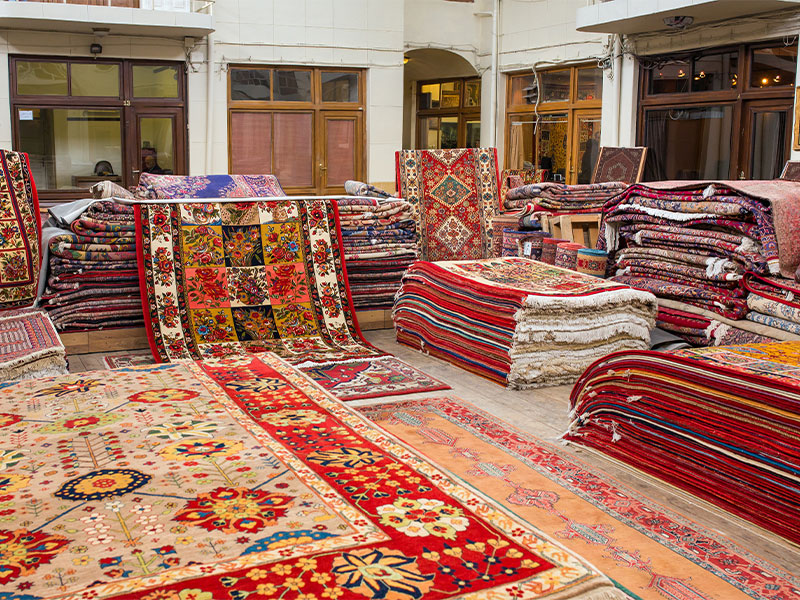
Persian Carpet Weaving: Persian carpets are renowned worldwide for their exquisite craftsmanship and intricate designs. Each carpet is meticulously handwoven, often taking months or even years to complete. Persian carpets come in a variety of styles, including traditional floral motifs, geometric patterns, and pictorial designs.
Termeh Weaving: Termeh is a luxurious handwoven fabric made from silk and wool, adorned with elaborate patterns and designs. It’s often used to make traditional Persian clothing, tablecloths, and decorative items, showcasing the heritage of Iranian textile arts.
Khatamkari (Wood Inlay): Khatamkari is a traditional Persian woodworking technique that involves inlaying intricate geometric patterns onto wooden surfaces. This art form requires precision and attention to detail, resulting in stunningly beautiful decorative objects, such as jewelry boxes, picture frames, and chessboards.
Ghalamzani (Metal Embossing): Ghalamzani is the art of embossing intricate designs onto metal surfaces, such as copper, brass, and silver. Iranian artisans use specialized tools to create elaborate patterns and motifs, often inspired by nature and Islamic art.
Pottery and Ceramics: Iran has a long history of pottery and ceramic production, dating back thousands of years. Iranian pottery is known for its exquisite craftsmanship and diverse styles, ranging from traditional blue and white ceramics to colorful glazed tiles and intricate relief work.
Qalamzani (Metal Engraving): Qalamzani is the art of engraving intricate designs onto metal objects, such as trays, vases, and decorative plates. Iranian metal engravers use fine-tipped tools to create detailed patterns and motifs, reflecting the rich artistic heritage of the region.
Gereh-chini (Tilework): Gereh-chini is the art of creating decorative tile mosaics, often used to adorn the facades of buildings, mosques, and palaces. Iranian tilework is renowned for its intricate geometric patterns, vibrant colors, and symbolic motifs, adding beauty and elegance to architectural structures.
Filigree (Ghalam Zani): Filigree is the delicate art of twisting and soldering fine metal wires to create intricate designs and patterns. Iranian filigree artisans produce stunning jewelry, ornaments, and decorative objects, showcasing their skill and creativity in working with precious metals.
Naqashi (Painting): Naqashi is the art of painting intricate designs and motifs onto various surfaces, including wood, metal, and ceramics. Iranian painters use a combination of traditional techniques and modern styles to create visually stunning artworks that reflect the rich cultural heritage of Iran.
These are just a few examples of the rich tapestry of Iranian handicrafts, each reflecting the skill, creativity, and cultural heritage of its artisans. Through these traditional art forms, Iran continues to preserve and celebrate its rich cultural heritage, captivating the world with its beauty and craftsmanship.
Handicrafts are an important part of a country’s culture and hold special significance. By familiarizing ourselves with the handicrafts of each city or country, we can learn more about the way people lived in the past. Today, handicrafts are of particular importance and appeal to many people. Even when traveling, most people choose to buy handicrafts from the city they visit as souvenirs. Therefore, June 10th is celebrated as World Handicrafts Day. It’s interesting to note that Iran is among the countries with the most diverse range of handicrafts. Some of the Iranian handicrafts you will become more familiar with today include:
- Straw Weaving
- Termeh (a type of handwoven fabric)
- Copper Utensils
- Enameling
- Handwoven Carpets
- Traditional Embroidery
- Pottery
- Tilework
- Woodcrafts
- Painting
- Felting
- Leather Crafts
1.Straw Weaving
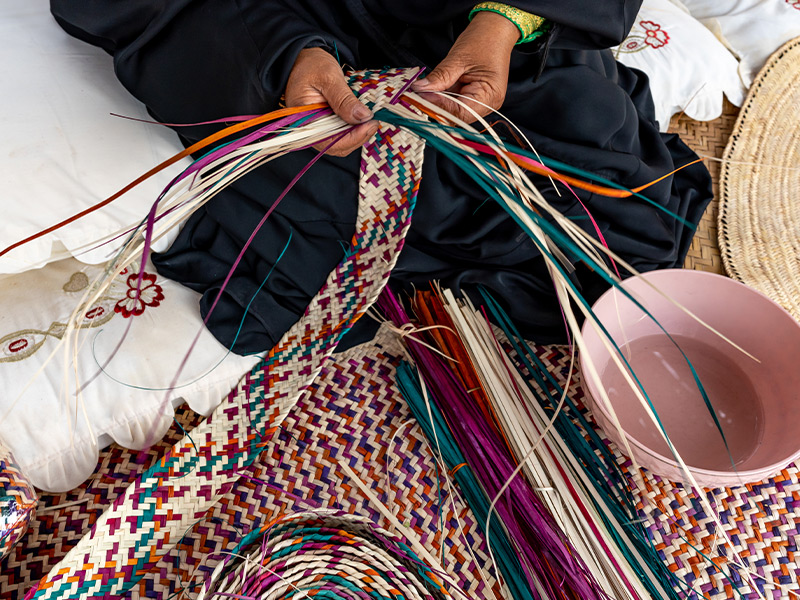
The first Iranian handicraft we’re delving into today is straw weaving. Nowadays, straw weaving in Iran is mostly used for home decoration. This art, which is one of the oldest handicrafts in the world, involves weaving strands of plant fibers, namely straw, together. If we trace the footsteps and limited artifacts discovered in Africa and Mesopotamia, we’ll find that in the past, these people used to create straw by weaving grasses together. Currently, 16 countries have straw weaving listed as part of their historical records, with Japan, Korea, and Mexico being among the most famous.
Straw weaving is an industry that still holds significant popularity in our country. These straws are made in various shapes and sizes. The raw materials for straw weaving vary in different cities and countries. Choosing suitable wood for making straw is done according to the climate of different regions. The weaving method of straw also varies depending on the climate. However, all straws are made from straw fibers.
Where is straw weaving practiced in Iran?
As mentioned, straw weaving still has many enthusiasts in our country and is one of the most extensive handicrafts in Iran. Straw weaving can be observed in various forms in all cities of Iran, but provinces such as Sistan and Baluchestan, Kurdistan, Khuzestan, Bushehr, Khorasan, Hormozgan, Kerman, Yazd, Fars, Mazandaran, Gilan, East Azerbaijan, and Tehran are among the leading provinces in this industry.
If you have traveled to the north of the country, you have surely become familiar with the straw weaving handicrafts of Gilan or the various types of straw weaving in Mazandaran. In the northern regions of the country, straw weaving is mostly done with machines and used as underlays.
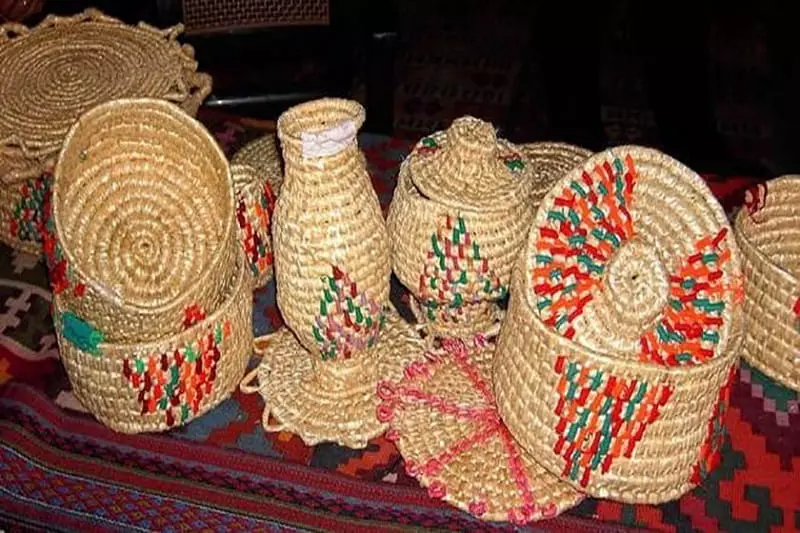
In desert areas like Bayazeh or Nayin, mostly palm trees are used, but in other cities like Najafabad, soft branches of one or two-year-old trees are used. The baskets made in this region are called “Ludah.” In the Qasr-e Shirin region, young date palm branches are used, and it is called “Fossil.”
Due to the specific climatic conditions of the Sistan and Baluchestan region and the affordability of raw materials for straw weaving, the straw weaving industry there holds special importance. Straw weaving is known as “Asil” in Sistan. Asil is the name of a type of straw. Another type of wood used in this region is called “Tagard.”
The Best Straw Weaving in Iran
Straw weaving is prevalent and flourishing in many cities across Iran, with each city offering various shapes and diverse applications of straw products. Consequently, the industry of straw weaving is extensive and distinct. Some cities are particularly renowned for their straw weaving industry due to their unique characteristics and widespread fame. These include Khuzestan, known for its abundant palm trees; northern cities like Gilan, famous for its numerous rice fields; and Sistan and Baluchestan, due to its climate and affordability of raw materials.
2.Termeh Fabric
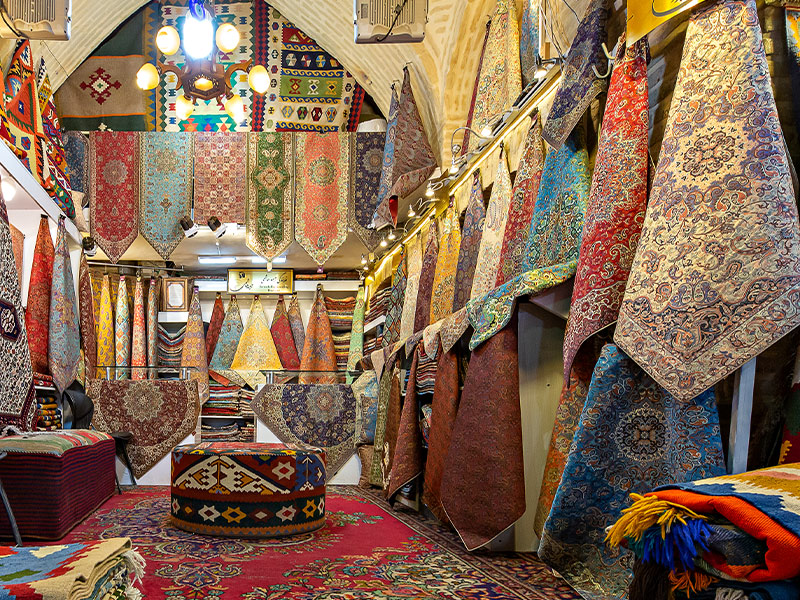
The second Iranian handicraft that holds great value and captivates your eyes is Termeh fabric. Termeh is one of the exquisite Iranian fabrics that we all recognize with its distinctive paisley pattern. The fibers of this fabric are very delicate and are made from various raw materials such as cotton, wool, or silk, and it is produced in a variety of colors, patterns, and designs. The back of the Termeh fabric is loose and has a high density, but the front of the fabric appears smooth and uniform.
Where is Termeh fabric produced in Iran?
Termeh is produced in various cities, but its origin is in the city of Yazd, and the finest ones are woven in this city. Since Yazd was on the Silk Road in the past, fabrics and textiles were the most important commodities traded in this region. Some sources also consider Kerman as the starting point of the Termeh weaving industry. However, the Termeh weaving industry is dwindling and is only active in limited capacity in cities like Yazd, Kashan, Kerman, and Tehran.
Types of Termeh
These delicate fabrics with their special and diverse patterns, which are considered one of the Iranian handicrafts, have various types. Here are some examples of Termeh types:
- Four-sided Shawl
- Striped Shawl
- Cashmere Shawl
- Atabaki Shawl
- Banded Shawl
- Mahramat Shawl
- Emerald Shawl
- Kerman Shawl
- Amiri Shawl
- Yazdi Shawl
- Belted Shawl
3.Copper Utensils
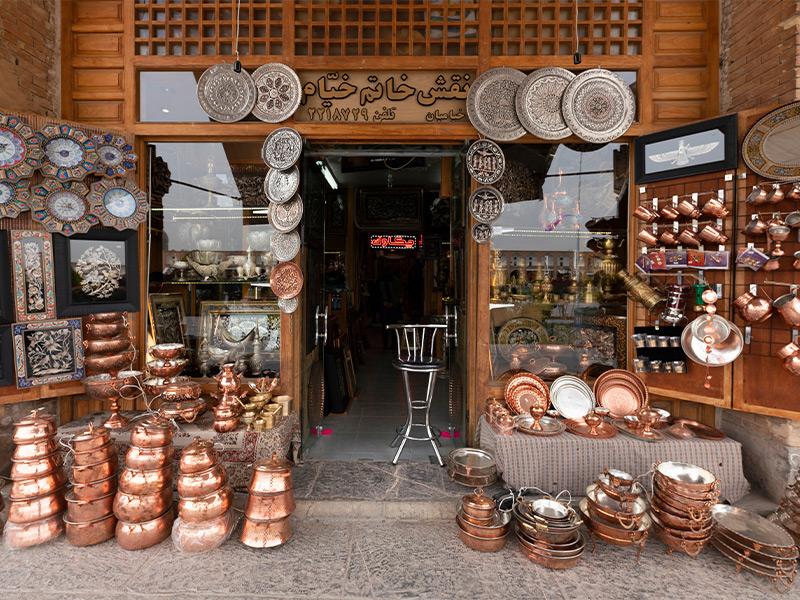
Copper was the first metal that humans were able to discover. History shows that humans used copper for various purposes. They would melt the copper, then shape it into various tools such as knives, and even decorative items like pendants were made after the widespread use of copper alongside essential tools like knives.
Copper utensils are one of the oldest items used for cooking and serving, known for their longevity, heat resistance, and beautiful color. Copper utensils are among the most common handicrafts in Iran.
Where can the best copper utensils be found in Iran?
The history of copper usage dates back to 9,500 years before Christ, and in our country, copper and coppersmithing have a long history in Zanjan Province. The use of copper utensils has revived almost two decades after the use of plastic utensils and materials, and these vessels have entered the market with various decorations. Zanjan Province is one of the most active provinces in producing copper products and utensils. After that, Tehran and Isfahan have the highest number of copper utensils as Iranian handicrafts.
Differences between Zanjan and Isfahan copperware
Zanjan and Isfahan are both among the oldest producers of high-quality copper, but there are slight differences between the copperware of these two cities that it’s better to know. The differences between Zanjan and Isfahan copper are:
- Zanjan copper utensils have a much wider variety compared to Isfahan.
- Isfahan coppersmiths produce works such as engraving, Khatam (a form of marquetry), and turquoise inlays, which are rarely produced in Zanjan.
- High-quality cooking copper utensils are produced in Zanjan.
- Most of the products of Isfahan coppersmiths are decorative utensils.
- Copper utensils are part of Iran’s handicrafts.
Points related to copper utensils
Although the production of copper utensils is considered one of Iran’s handicrafts, it is also used in our daily lives, especially in cooking. Copper utensils have a special place in kitchens, and it is necessary to know some points regarding their use in cooking.
Copper utensils come in two colors: red (pure copper) and white (tin-plated). For cooking purposes, beverages, various pickles, and other materials that can dissolve copper, white utensils should be used. White here means that the surface in contact with these materials should be tin-plated.
Excessive copper absorption into the body can lead to poisoning. (As long as there is a layer of tin plating on the copper, there is no problem.)
For dry food items such as pastries, etc., you can use copper utensils without tin plating without concern.
It is recommended to use gentle heat and flame to increase the lifespan of utensils and cook food better.
4.Enameling
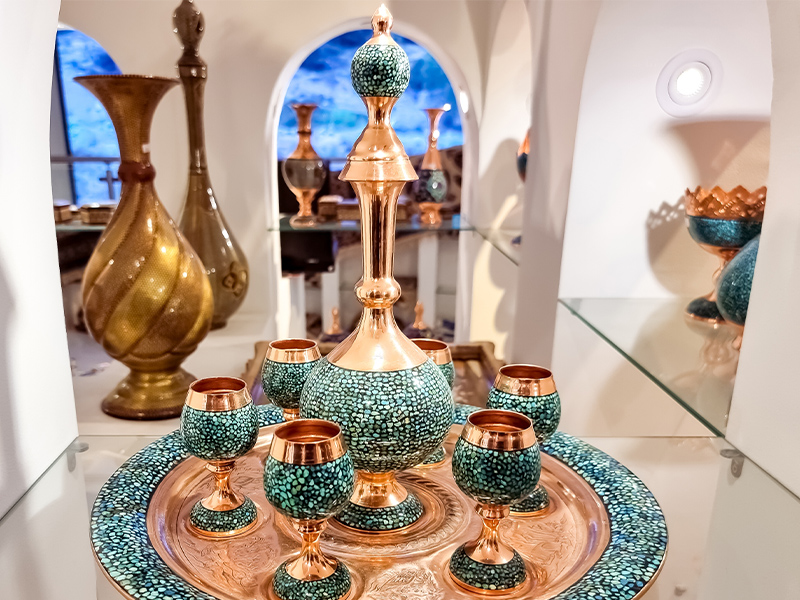
Enameling is one of the most beautiful handicrafts in Iran with a history of 5,000 years. The origin of enameling started in Iran and then this beautiful art found its way to other parts of the world. This art reached its peak during the Seljuk period when they used brass vessels for enameling, which became very popular among the people. Enameling art changed during the Mongol rule, and a new method emerged where they created new designs using various shapes and images.
5.Handwoven Carpets
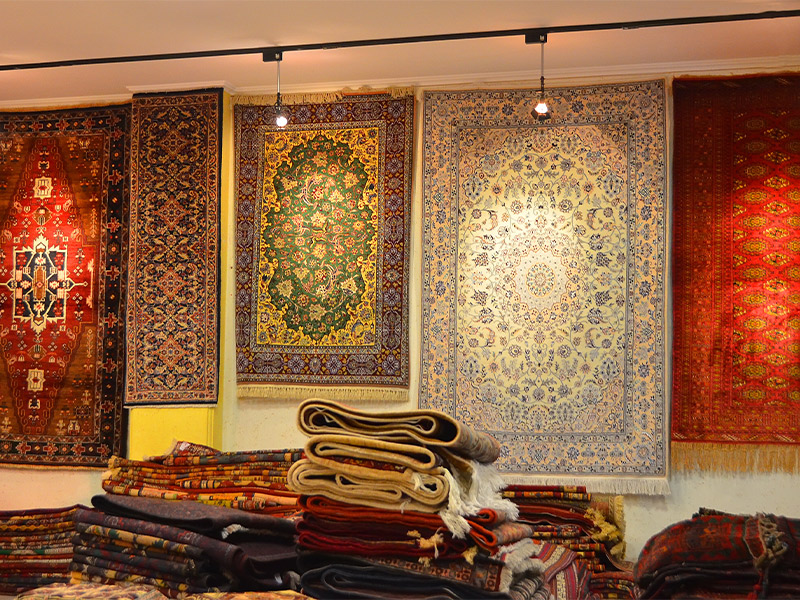
Iranian carpets have been renowned worldwide from ancient times to the present day. Iranians have been pioneers in carpet weaving, turning Iranian carpets into symbols of art, culture, skill, and authenticity. The history of Iranian handwoven carpets dates back to the Sassanid, Achaemenid periods, and several centuries BC. Over time, the diversity of handwoven carpet designs has also increased, attracting more enthusiasts of this type of carpet. Today, it cannot be precisely stated which city produces the best handwoven carpets, but carpets from some regions of Iran, such as Isfahan, are more famous and have more fans. Handwoven carpets have been made with two types of knots, Persian and Turkish, from the past to the present.
Types of Authentic Iranian Carpets
The evolution of Iranian handwoven carpets has always been on a growing path due to the abundant taste and talent of Iranians. For this reason, today we witness a wide range of authentic Iranian handwoven carpets, which are prominent figures in Iran’s handicrafts and are popular and well-known among Iranians and people worldwide. Types of authentic Iranian carpets include:
- Ghabeh
- Kilim
- Jajim
- Persian carpet
And special modern carpets with beautiful and unique patterns are produced. The most famous ones include:
- Tabriz Carpet
- Kashan Carpet
- Qom Carpet
How to Identify a Good Iranian Carpet?
In general, carpets from Tabriz, Qom, Kashan, and northern regions of Iran are among the most popular Iranian carpets. Keep in mind that apart from personal criteria for choosing and purchasing carpets, it is better to consider factors such as the material of the carpet’s pile, the number of knots per square inch, the serial number and warranty of the carpet, the dimensions of the carpet, the carpet’s pile, and the back of the carpet to find the best carpet for your needs.
6.Iranian Traditional Embroidery
Another of Iran’s handicrafts is traditional embroidery, with a history dating back to the era of homebuilding and pottery, which is equivalent to about ten thousand years! The use of traditional embroidery in today’s modern world is mostly for decorative purposes.
7.Pottery
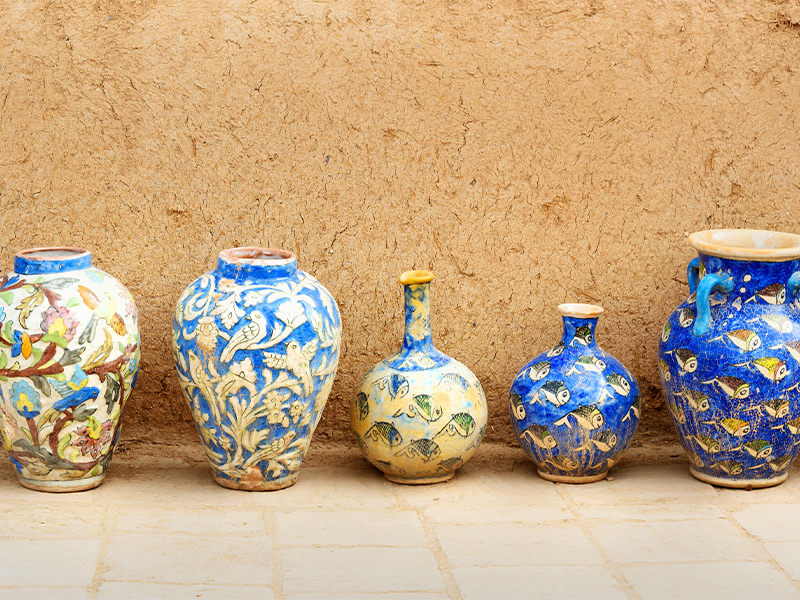
Pottery vessels are one of the oldest handmade artifacts of humanity. Initially, these vessels were used for storing water and food, but with the growth, evolution, and advancement of the world, beautiful designs and patterns emerged on these pottery vessels.
In which cities of Iran is pottery common?
This ancient art, dating back ten thousand years, produces pottery vessels in areas of Iran such as Minab in Gonabad, Laljin in Hamadan, Meybod in Yazd, Shahreza in Isfahan, Zenooz in Azerbaijan, Kalpoorgan in Sistan and Baluchestan, Juybar in Mazandaran, and Siahkal in Gilan. However, the capital of pottery in Iran is Laljin in Hamadan. Interestingly, the primary occupation of the people of this city is pottery, followed by agriculture. For this reason, the first rank of pottery exports in the country belongs to this city.
The high-quality pottery produced in this region is still made using manual wheels.
8.Eglomisé Handicrafts

Eglomisé is another of Iran’s handicrafts, referring to the art of decorating glass used in various items. This art has developed based on broken glass and glass shards and is prominent in cities such as Tehran, Isfahan, Meymand, Qamsar, and more, attracting the attention of artists and artisans.
Among the subsets of eglomisé art, we can mention molded glass, frosted glass, triple-layered glass, double-layered glass, glass engraving, water marbling, and matte work. Also, beautiful handicrafts have been created by Iranian artisans by combining this art with enamel work and metal handicrafts.
In some sections of the Museum of Pottery and Eglomisé Handicrafts, this beautiful and eye-catching art has been showcased. Some of the handicrafts presented in the Eglomisé Museum date back more than four thousand years, which is indeed a delightful sight to behold.
9.Wooden Handicrafts
Wooden handicrafts are among the most beloved handicrafts in Iran. Decoration of wooden artifacts is often done after constructing the body. Initially, the main body of the object is crafted using various carpentry and joinery techniques. Then, decoration work is carried out using different methods on their surface or by affixing pre-made layers.
Types of Wooden Handicrafts
Wood, as the primary material for wooden handicrafts, has held a special place in the art and industry of Iran since ancient times. Wooden handicrafts are beautiful and delicate, with various types produced using different techniques, each possessing unique beauty. Woodworking and decoration are carried out using methods such as carving, engraving, latticework, knotting, marquetry, delicate work, inlaying, marquetry carving, inlaid marquetry, and wooden carvings (sculptures).
Additionally, wood is used in the construction of musical instruments, contributing to Iran’s handicrafts.
10.Painting
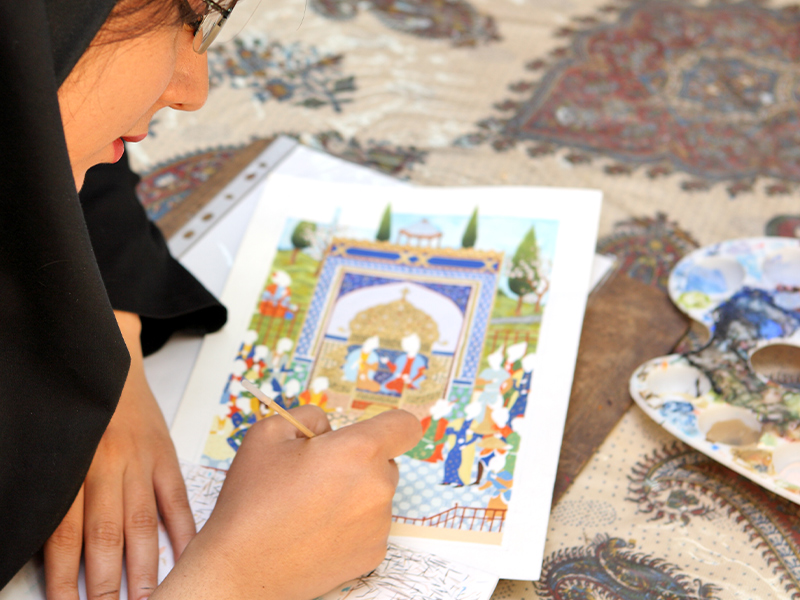
In essence, painting refers to various styles and methods of Iranian painting. The art of painting is rooted in Iranian poetry and literature, intertwined with the creativity of artists, and recognized as one of Iran’s handicrafts. A painter alters the thickness of lines and the arrangement of convergent, parallel, or curved lines with a pen, leading to the emergence of light and shadow and volume in the painting. Line and penmanship are the two main pillars of Iranian painting.
Iranian painting, or miniature painting, possesses five unique features:
- Use of pen lines instead of relying on shading
- Creation of luminous spaces without specific angles
- Utilization of bright and flat colors
- Emphasis on surface and avoidance of perspective and depth representation
- Presentation of objects from the best viewpoint
11.Felting

Felting, and the art of felting, is a traditional weaving technique produced with wool. Felting is essentially a type of underlay. What’s interesting is that felting is not woven like carpets; rather, it is created by applying pressure, moisture, and heat, causing the wool fibers to interlock and form felt. The material used for felting is sheep wool, possessing the unique property that allows felting to be made from it. Producing a piece of felt typically takes one day, and felting artisans often work in pairs. Among the various handicrafts of Iran, felt products include underlays, felt hats, and felt coats (known as “kapanak”).
Iranian Handicrafts
Felting is produced in most cities of Iran. Major production centers are located in Isfahan, Gilan, Mazandaran, Semnan, Damghan, Quchan, Chaharmahal and Bakhtiari, and Kermanshah. It might be said that the best and highest-quality felts in Iran are produced in Chaharmahal and Bakhtiari. Due to the quality, variety, innovation, and creativity in felt production in this province, Shahrekord was selected as the National Felting City in July 2015.
12.Leather Handicrafts
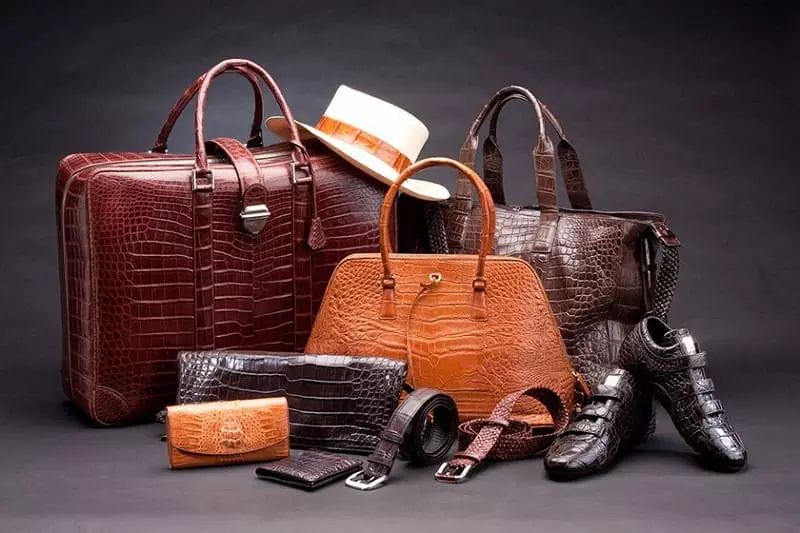
Throughout history, humans have used leather for making clothing, shoes, and even writing on leather pages. Over time, humans have been able to create various handicrafts in the field of leather. Leather is one of the most popular and widespread handicrafts in Iran and has remained popular from the past to the present.
The first industrial factories producing various types of natural leather were established in the provinces of Tabriz, Mashhad, and Isfahan.
Types of Leather Handicrafts
Leather is a natural, durable, and flexible material obtained through the tanning of raw animal hides such as cowhide. Although many provinces in Iran are active in the leather industry, if we were to mention the most vibrant and famous ones, Hamedan stands at the forefront of leather production. Following Hamedan, cities such as Tabriz, Tehran, East Azerbaijan, Khorasan, Alborz, and Isfahan lead in leather production. The most important types of leather handicrafts include:
- Traditional saddle-making (hand-stitched leather)
- Leather upholstery
- Leather burning
- Leather engraving
- Leather painting
Conclusion
Iranian handicrafts hold a special place in the world and among ourselves. Despite the significant artistry and creativity employed in these handicrafts, there is a lot of effort hidden behind each of these artistic works. Familiarity with Iranian handicrafts is like a journey to the past, acquainting us more with Iranian art and creativity. Through this journey, we introduced you to 12 of the most fascinating Iranian handicrafts, such as enamelwork, painting, and glassware. Although in some cities, handicrafts are not supported as they should be, and some Iranian handicrafts, like felt weaving, are becoming obsolete, we have endeavored to contribute, albeit modestly, to preserving these arts by introducing them.
Frequently Asked Questions
What plant is used in straw weaving?
The plant used in straw weaving varies depending on different climates. In tropical regions, palm leaves, wild palm leaves, and straw stems are predominantly used. Among the plants used in southern regions are Kortek (a type of straw stem) and Daz (a type of wild palm wood).
What is the fabric of Termeh made of?
High-quality Termeh fabric must be made of natural silk and cotton threads. Silk, cotton, or rayon threads are used for the weft of this fabric. Although most modern Termeh fabrics use rayon viscose for the weft, their warp threads are made of cotton or polyester.
Why is the use of copper utensils recommended for cooking?
Copper utensils ensure proper heat transfer, resulting in better food flavor and taste. Additionally, food cooks faster in copper utensils.
Why is the price of Iranian handmade carpets higher?
Handmade carpets are among the oldest and most authentic carpets, with higher material and intrinsic values. The primary materials used in carpet weaving, such as wool, silk, and pure cotton, contribute to their higher price. In machine-made carpets, a percentage of plastic materials is added, reducing the overall cost.
What is “Qalamgiri” in painting?
“Qalamgiri” refers to the technique of holding the brush by the artist. The brush should be held vertically between the index and middle fingers for easy movement of the brush tip in any direction.
The Most Beautiful Handicrafts of Iran ?
Handicrafts such as weaving and textiles, traditional embroidery, metalworking, enamelwork, pottery, tilework, woodworking, stonemasonry, and painting are considered among the finest handicrafts of Iran.
Where is the best place to buy Iranian handicrafts?
Specialty handicraft shops operate in various cities for purchasing Iranian handicrafts.
How many Iranian cities are listed in the global handicrafts list?
Iran ranks at the top of the list of countries with 11 cities and three villages registered in the global list of handicrafts.
In how many fields of handicraft does Iran engage?
Iran is one of the most active countries in this field, engaging in 370 out of 600 recognized fields of handicraft worldwide.

